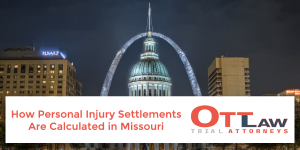## Grasping the Nuances of Compensation in Missouri Personal Injury Law
When navigating the complexities of personal injury law, understanding the concept of damages is paramount. Damages refer to the financial compensation awarded to an injured party as redress for losses incurred due to another’s negligence or wrongdoing. In Missouri, the legal landscape governing these damages can be intricate, shaped by various laws, case precedents, and the specific circumstances of each case. Recognizing how damages are calculated, categorized, and argued is essential for anyone involved in a personal injury claim, whether as a plaintiff or defendant.
Missouri’s personal injury law outlines various types of damages, including economic and non-economic damages. Economic damages are quantifiable losses such as medical bills, lost wages, and property damage, while non-economic damages cover more subjective impacts like pain and suffering, emotional distress, and loss of enjoyment of life. Understanding the distinction between these categories ensures that individuals can accurately appraise their claims, effectively communicate their needs, and receive the compensation they deserve for their suffering and losses.
The interplay between state laws and personal injury claims is also facilitated by statute limitations, which dictate the timeframe within which an individual must file a claim or lawsuit after an injury occurs. Familiarity with these nuances benefits not only the injured party but also anyone involved in the legal framework surrounding personal injury cases in Missouri. Legal representation, like that provided by the Ott Law Firm, can illuminate these complexities and bolster a client’s chances of achieving a favorable outcome.
## Defining Personal Injury Law and Its Elements
Personal injury law, a crucial subset of tort law, encompasses legal matters involving individuals who have been harmed due to another’s negligence, recklessness, or intentional misconduct. Within this framework, personal injury law aims to provide compensation to the injured party while holding the responsible party accountable. Cases can arise from various incidents, such as car accidents, slips and falls, workplace injuries, and medical malpractice.
The foundational element of a personal injury claim is establishing negligence, which involves demonstrating that the responsible party owed a duty of care, breached this duty, and caused harm as a result. This legal principle is pivotal since it governs the pursuit of damages in personal injury suits. Without a foundational understanding of negligence, claimants may struggle to articulate their case and secure the compensation they seek.
Additionally, personal injury law in Missouri incorporates the concept of comparative fault. This means that if an injured party is found to share some degree of fault in the incident, their awarded damages may be reduced proportionately. This highlights the need for a strategic approach to presenting evidence, making it crucial for claimants to meticulously document their case and seek legal guidance to navigate any potential impacts of shared fault.
## Significance of Understanding Damages in Personal Injury Claims
Comprehending damages in personal injury cases goes beyond mere financial metrics; it’s about grasping the full scope of losses endured by an injured individual. Recognizing the different types of damages—and how they are calculated—enables claimants to pursue a more comprehensive settlement, ensuring that no aspect of their suffering is overlooked. From economic losses, such as medical expenses and lost income, to non-economic damages that capture pain and emotional distress, each component plays a crucial role in the overall compensation awarded.
For individuals who have sustained life-altering injuries, understanding damages holds even greater significance. The implications of serious injuries often extend far beyond the immediate financial aspects, affecting quality of life, career potential, and personal relationships. By articulating these losses effectively in compliance with Missouri law, claimants can seek appropriate compensation that reflects the ongoing impact of their injuries.
Moreover, a solid understanding of damages can enhance negotiations with insurance companies. Often, these entities prioritize minimizing payouts over fairly compensating victims. Claimants armed with knowledge about what constitutes fair damages are better positioned to advocate for themselves, ensuring that they are treated with the respect and seriousness their claim deserves.
## Legal Framework Governing Damages in Missouri Personal Injury Cases
Missouri operates under specific legal statutes and precedents that govern the calculation and awarding of damages in personal injury cases. A key component of this framework includes the concept of limits on non-economic damages, established by Missouri law. These statutes outline caps or limits on the recoverable amount for certain categories of damages, particularly in cases involving medical malpractice. Understanding these limits is essential for the successful framing of a claim, especially as they may impact potential recovery amounts.
Missouri’s courts also apply a comparative fault system, as previously mentioned. This principle plays a vital role in determining the final award for damages. The process begins with assessing the degree of fault attributed to both parties. For example, if a claimant is found to be 20% responsible for the incident, their total awarded damages might be reduced by that percentage. Grasping how this legal framework influences recovery potential helps individuals prepare their cases more effectively, ensuring they account for all potential variables.
Additionally, statutes of limitations in Missouri dictate the timeframe within which a personal injury claim must be filed. Generally, individuals have five years from the date of the injury to file a lawsuit. Failing to initiate proceedings within this period can jeopardize the chance of recovery significantly. Understanding these legal timeframes is crucial for ensuring timely action, mitigating delays that could adversely affect a case.
## Illustrating Damages Through Real-World Personal Injury Cases
Real-world examples serve to illuminate the nuances of damages in personal injury law and highlight the importance of effective legal representation. Consider the case of a pedestrian struck by a negligent driver. The pedestrian may accrue substantial medical bills for rehabilitation, which would contribute to their economic damages. Furthermore, if the individual has to navigate physical therapy and face significant emotional distress, these non-economic damages also come into play.
In another instance, a workplace accident could result in serious injuries, leading to both immediate and long-term consequences. For example, a construction worker who sustains a debilitating injury while on the job not only faces extensive medical costs but also potential loss of income, future earning capacity, and the debilitating emotional effects of job loss. Such factors must be thoroughly analyzed and presented in their claim to ensure comprehensive compensation.
Additional complexities arise in cases involving multiple parties, such as mass torts or class-action lawsuits. In these circumstances, the determination of how damages are apportioned can become convoluted. Each claimant’s individual losses must be clearly articulated, and navigating these multifaceted cases demands a swift understanding of both personal injury law and the possible intersections of fault.
## Navigating the Personal Injury Claim Process: Essential Steps
Engaging with the personal injury claim process can be daunting, but taking strategic steps can facilitate the experience for claimants. The initial step typically involves assessing the claim’s viability, which includes reviewing the incident in question, compiling evidence, and determining liability. This process often includes gathering documents like medical records, accident reports, and witness statements—all vital components in constructing a solid foundation for a claim.
Following this assessment, it is important to document all incurred losses meticulously. This includes not only medical bills but also lost wages, out-of-pocket expenses, and any relevant impacts on daily life. Collecting comprehensive records can dramatically influence the outcome by providing tangible proof of the economic and non-economic damages being claimed. This documentation is critical in negotiations and can speed things up should the case proceed to court.
Furthermore, pursuing a personal injury claim necessitates effective communication and negotiation skills, especially when dealing with insurance companies. These entities often use strategies to minimize payouts. Therefore, understanding your rights and what constitutes fair compensation enables individuals to assertively advocate for their needs. Engaging an appropriate attorney can streamline this communication process, ensuring that claims are presented robustly.
## Common Pitfalls in Personal Injury Claims
In the pursuit of compensation, claimants can inadvertently make common mistakes that might undermine their cases. One prevalent pitfall involves underestimating the significance of comprehensive documentation. Failing to collect substantial evidence or neglecting to maintain records of medical visits, expenses, and other losses can severely impact the credibility of a claim and impair the ability to receive just compensation.
Additionally, there is often a tendency for claimants to settle quickly with insurance companies without fully understanding the extent of their injuries and the implications of their settlements. Insurers frequently propose early settlements that may appear beneficial, yet they may not account for long-term consequences, future medical needs, or ongoing emotional distress. Patients might later find themselves in financially precarious situations due to a lack of foresight.
Another common mistake occurs when individuals inadvertently make statements that could be construed as admissions of fault, potentially complicating their cases. Even casual remarks made to an insurance adjuster or during the claims process can be later leveraged against claimants, hindering their ability to recover damages. It is essential for individuals navigating the personal injury landscape to understand their rights and strategize communications carefully.
## The Importance of Consulting with Legal Professionals
Engaging with a legal professional during personal injury claims is not just beneficial but often imperative to achieving favorable outcomes. Attorneys specializing in personal injury law offer advanced knowledge of the pertinent local laws, helping clients navigate complex legal terrain and avoid pitfalls. Their guidance can make a notable difference in terms of compensation achieved, as they understand the nuanced nature of different types of damages and how best to present these in a compelling manner.
The consultation process provides an opportunity for individuals to discuss the particulars of their case, investigate options, and lay groundwork for potential legal action if necessary. Attorneys can assist in gathering evidence, managing documentation, and serving as a crucial advocate during negotiations. This support is particularly important in interactions with insurance companies, where professionals can intervene to ensure clients’ rights are safeguarded.
Moreover, having legal representation often sends a clear signal to insurers that the claimant is serious about pursuing adequate compensation. Insurers are typically more willing to negotiate fairly when an attorney is involved, as it indicates that the claimant is equipped with expert knowledge and may be prepared for litigation if necessary. This can contribute positively to the overall claims experience.
## How Ott Law Firm Can Support Your Personal Injury Case
The Ott Law Firm specializes in guiding clients through the intricacies of personal injury law in Missouri. Their profound understanding of local statutes, coupled with a relentless commitment to client advocacy, positions them as an invaluable resource for individuals seeking compensation for injuries sustained due to negligence. The firm understands that each case is unique, necessitating tailored legal strategies that consider individual circumstances and evidence.
With extensive experience in handling complex personal injury cases, the Ott Law Firm employs a meticulous approach to evidence gathering and case preparation. Their team works diligently to ensure that each client’s story is accurately represented, enabling them to articulate the full extent of damages suffered, both economic and non-economic. This commitment to detail is crucial in advocating for fair compensation.
Furthermore, Ott Law Firm prioritizes open communication and transparency throughout the legal process. Clients are kept informed every step of the way, ensuring they feel supported and empowered as they pursue their claims. By combining legal proficiency with genuine care for their clients’ well-being, the Ott Law Firm stands out in Missouri’s legal landscape, making them an excellent choice for personal injury representation.
## Frequently Asked Questions Regarding Personal Injury Law
### Additional Resources
For those wishing to delve deeper into personal injury law and its implications in Missouri, a wealth of resources is available. This includes state statutes regarding personal injury claims, guidelines provided by local bar associations, and publications from legal advocacy groups focused on educating the public about their rights and options in personal injury cases. Additionally, numerous online platforms offer guidance and support for individuals navigating the claims process, providing access to templates, checklists, and informative articles that can assist in preparation and strategy. Always consult credible sources and consider legal advice to ensure accurate and applicable information tailored to specific circumstances.














